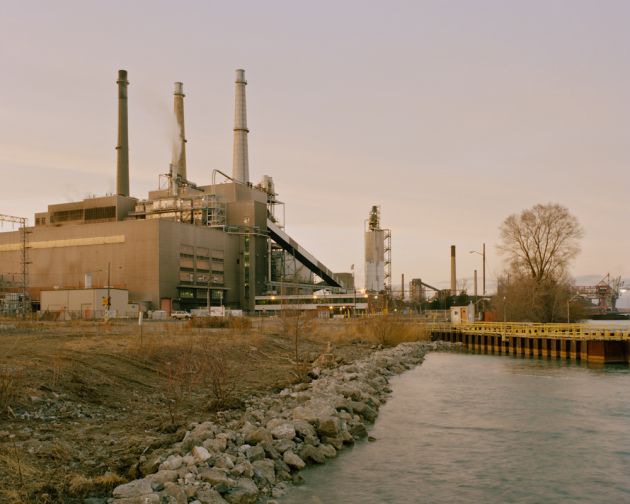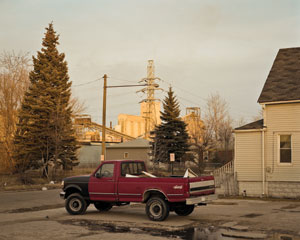How a Grassroots Rebellion Won the Nation's Biggest Climate Victory
Activists have imposed a de facto moratorium on new coal—and beat the Obama EPA to the punch.

The River Rouge plant on the banks of the Detroit River emits enough pollution to cause 44 deaths each year.
By most accounts, the summer of 2010—when climate legislation died its slow, agonizing death on Capitol Hill—was not a happy time for environmentalists. So why was Mary Anne Hitt feeling buoyant, even hopeful? Part of the reason, no doubt, were the endorphins of first-time parenthood. Baby Hazel, born in April 2010, was fair like her mother and curly haired like her father. She was also an 11th-generation West Virginian, which perhaps explained her mom's other preoccupation: stopping mountaintop-removal coal mining in Appalachia. Hitt had spent the better part of a decade in Boone, North Carolina, running an organization called Appalachian Voices that sought to end mountaintop removal.
Wading through her backlog of emails after she returned from maternity leave, Hitt was struck by how "defeated and despondent" her fellow environmentalists sounded. She understood why, of course: "We'd just spent a great deal of money, time, and energy trying to pass a climate bill," an effort that had cost mainstream green groups more than $100 million.
But Hitt's emails were telling other stories, too—stories that were not getting her Beltway colleagues' attention. Across the country grassroots activists were defeating plans to build coal-fired power plants, the source of a quarter of America's greenhouse gas emissions. The movement's center of gravity was in the South and Midwest, "places like Oklahoma and South Dakota, not the usual liberal bastions where you'd expect environmental victories," she recalls. (The defeat of the Shady Point II plant in Oklahoma was particularly sweet, coming in the home state of DC's leading climate denier, Sen. James Inhofe.)
Hitt knew about these victories because she had helped bring them about. In 2008 she had left Appalachian Voices and taken a job as deputy director of the Sierra Club's Beyond Coal campaign, which aimed to defeat every proposed coal plant, anywhere in the country. "I realized the Sierra Club was winning," she explains, "and I wanted to win."
By the time Senate Majority Leader Harry Reid (D-Nev.) declared the cap-and-trade bill dead in July 2010, the Beyond Coal campaign had helped prevent construction of 132 coal plants and was on the verge of defeating dozens more. It had imposed, noted Lester Brown of the Earth Policy Institute, "a de facto moratorium on new coal-fired power plants."
To be sure, the activists had help. The recession caused electricity demand to plummet, as did a shift to more energy-efficient appliances, motors, and industrial processes. Why build a power plant, coal or otherwise, if demand didn't justify it? Coal was also hurt by its own rising costs—especially as natural gas, its chief competitor, stayed relatively cheap.
But those economic trends only made coal somewhat vulnerable, argues Tom Sanzillo, a former New York state deputy comptroller who has worked with the Beyond Coal campaign; it was grassroots activism that leveraged vulnerability into outright defeat. The movement's strength was grounded in retail politics—people talking with friends and neighbors, pestering local media, packing regulatory hearings, protesting before state legislatures, filing legal challenges, and more. The movement had no official membership rolls; it was populated by clean energy advocates, public health professionals, community organizers, faith leaders, farmers, attorneys, students, and people like Verena Owen, a self-described permit nerd from Illinois who was inspired to oppose coal by a friend who died of lung cancer in her 40s.
"My friend had four boys, just like I do," says Owen. "I never had to read the news to find out what the air quality was; I could just call her, and if she was having trouble breathing, that told me all I needed to know." Owen proved so capable, she was recruited to work with Hitt in leading the Beyond Coal campaign.
Stopping new coal plants may be "the most significant achievement of American environmentalists since the passage of the Clean Air Act and the Clean Water Act" in the 1970s, says Michael Noble of the Minnesota environmental group Fresh Energy. As this article goes to press, 166 proposed coal-fired power plants have been canceled, legally barred, or otherwise stopped from going forward in the United States. That means that each year, 654 million metric tons of carbon, the equivalent of 9.5 percent of US emissions, won't be entering the atmosphere. The proposed cap-and-trade legislation would, at best, have reduced annual emissions by 16 percent as of 2020. (That's compared with 2010—though compared with 1990, the baseline used by scientists and international negotiations, cap and trade would have achieved only a 5 percent reduction (PDF).)
 See
more photos of the River Rouge plant.So
why does this landmark shift in the fight
against climate change remain unknown to
most Americans? Largely it's because
national media and even many
environmentalists view the climate issue
through the lens of official Washington.
When cap-and-trade legislation failed, the
conventional wisdom became that the US was
simply incapable of taking meaningful
action; corporate polluters were too strong,
the political system too dominated by
industry money, the public too confused and
apathetic.
See
more photos of the River Rouge plant.So
why does this landmark shift in the fight
against climate change remain unknown to
most Americans? Largely it's because
national media and even many
environmentalists view the climate issue
through the lens of official Washington.
When cap-and-trade legislation failed, the
conventional wisdom became that the US was
simply incapable of taking meaningful
action; corporate polluters were too strong,
the political system too dominated by
industry money, the public too confused and
apathetic.
But the moratorium on new coal shows that Americans "don't have to wait for Washington to get the country on the right climate track," Hitt argues. "This campaign has demonstrated we can do this state by state, plant by plant, town by town. Not just that we can do it, but we are doing it."
That success—a clear demand backed by a
grassroots campaign, rather than an
incremental, inside-the-Beltway
strategy—presents a lesson for organizers,
but it also presents challenges as Beyond
Coal grapples with the complexities inherent
in its name. What will replace the power
from the coal plants not being built? How
will communities deal with the loss of the
taxes they pay, and the decent-paying, often
union, jobs they bring? How the movement
answers those questions may shape climate
politics—including whatever ultimately
happens in Washington—for years to come.
Beyond coal's one moment in the national spotlight came last summer, when on a searing July morning, New York City Mayor Michael Bloomberg stood before a microphone in Alexandria, Virginia. Behind him, shimmering in the 100 degree heat, loomed the five smokestacks of the Potomac River Generating Station. The plant, which began operating in 1949 and was never required to install modern pollution controls, has been in the crosshairs of local activists for years; shortly before Bloomberg's appearance, Beyond Coal had released a study that showed its pollution was drifting across the Potomac to Washington, DC. (The plant is now slated to shut down this year.)
Flanked by Hitt and Sierra Club executive director Michael Brune, Bloomberg announced that his personal foundation, Bloomberg Philanthropies, would contribute $50 million to the campaign's new push to close existing coal plants. Bloomberg, who has long been passionate about public health (recall his 2006 restaurant trans-fat ban), cited EPA data (PDF) to explain his decision: "Every year, coal-burning power plants like this one cause more than 200,000 asthma attacks nationwide, many of them affecting children," he said. "Coal pollution also kills 13,000 people every year and costs us $100 billion in medical expenses.
"Thirteen thousand people," he repeated, "from something that's planned. And it's going to happen again next year and the year after, unless we do something about it."
Map: The Cross-Country Fight Against Coal

Bloomberg's donation will enable Beyond Coal to double down on its second phase—moving beyond blocking new plants to seeking to close a third of the roughly 580 existing ones (PDF) by 2020. The money, says Brune, will help expand the campaign's paid staff from 102 to 192, including 84 organizers who will be "working on nothing but figuring out how to shut down these plants and replace them with clean energy."
But boots on the ground are only as effective as the battle plan they are executing. Thus, Beyond Coal will also use some of Bloomberg's millions to develop a detailed blueprint for the challenge ahead. How can communities that rely on coal move beyond it without committing economic suicide?
It's not an easy task, Beyond Coal leaders concede. And few places illustrate the difficulty—and the urgency—better than a small town with the deceptively gentle name of River Rouge.
